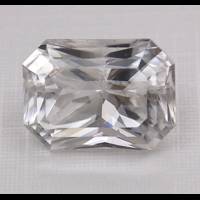Dolomite

Austria
6.67 carats
Dolomite forms white, gray to pink rhombohedral crystals, some of them exhibit curved growth, possibly a result of twinning. It can also be massive. Small amounts of iron in the structure cause a yellow to brown tint. A high manganese content gives the crystals a rosy pink colour.
Dolomite Gemstones by Colour
This table shows the variety of hues this gemstone can be found in. Click on a photo for more information.
Dolomite Gemstones by Size
This table shows distribution of Dolomite gemstone sizes that are listed on this site. This can give a good indication as to the general availability of this gemstone in different sizes.
Contributed photos
Lightest:6.67 cts
Heaviest:16.39 cts
Average:9.92 cts
Total photos:4
Do you have a larger Dolomite? Why not upload a photo?
| General Information | ||||||||||||||
|---|---|---|---|---|---|---|---|---|---|---|---|---|---|---|
| Chemical Formula |
| |||||||||||||
| Physical Properties of Dolomite | ||||||||||||||
| Mohs Hardness | 3.5 to 4, Blue Chart Gem Identification (2010) More from other references | |||||||||||||
| Specific Gravity | 2.80 to 2.95, Blue Chart Gem Identification (2010) More from other references | |||||||||||||
| Tenacity | Brittle, Blue Chart Gem Identification (2010) | |||||||||||||
| Cleavage Quality | Perfect, Gemmological Tables (2004) More from other references | |||||||||||||
| Fracture | Sub-Conchoidal, Gemstones (2009) | |||||||||||||
| Heat Sensitivity | Sensitive to heat, Blue Chart Gem Identification (2010) | |||||||||||||
| Optical Properties of Dolomite | ||||||||||||||
| Refractive Index | 1.498 to 1.681, Blue Chart Gem Identification (2010) More from other references | |||||||||||||
| Optical Character | Uniaxial/-, Blue Chart Gem Identification (2010) More from other references | |||||||||||||
| Birefringence | 0.179 to 0.181, Blue Chart Gem Identification (2010) DoublingMore from other references | |||||||||||||
| Pleochroism | Nil, Gemstones (2009) | |||||||||||||
| Dispersion | Low, Gemstones (2009) | |||||||||||||
| Colour | ||||||||||||||
| Colour (General) | White, yellowish, brownish, Gemmological Tables (2004) Commonly bandedMore from other references | |||||||||||||
| Transparency | Transparent,Translucent,Opaque, Gemmological Tables (2004) More from other references | |||||||||||||
| Lustre | Vitreous,Pearly, Gemstones (2009) | |||||||||||||
| Fluorescence & other light emissions | ||||||||||||||
| Fluorescence (General) | Inert to light orangy, bluish, greenish, Blue Chart Gem Identification (2010) | |||||||||||||
| Crystallography of Dolomite | ||||||||||||||
| Crystal System | Trigonal, Blue Chart Gem Identification (2010) More from other references | |||||||||||||
| Habit | Rhombohedral, massive, Gems, Sixth Edition (2006) More from other references | |||||||||||||
| Geological Environment | ||||||||||||||
| Where found: | Dolomite occurs in a number of conditions: in sedimentary rocks, in altered Mg-rich igneous rocks or in geodes., Gems, Sixth Edition (2006) | |||||||||||||
| Further Information | ||||||||||||||
| Mineral information: | Dolomite information at mindat.org | |||||||||||||
| Significant Gem Localities | ||||||||||||||
| ||||||||||||||



